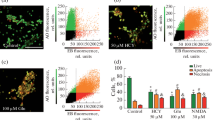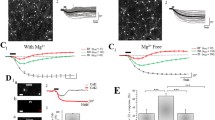Abstract
Exposure of guinea pig brain slices to low concentrations (10 μM) of NMDA caused decreases in PCr and ATP within 30 min, with a slower decrease in NAA and increase in lactate, both detectable after 1 h. Exposure to NMDA for over 1 h or at higher concentrations caused further increases in lactate and decreases in NAA, with no further change in PCr or ATP. The L-isomer, NMLA, and the racemic mixture, NMDLA, caused similar changes in lactate and NAA, but both produced greater decreases in the energy state than NMDA, similar to those caused by prolonged exposure to glutamate. MK-801 prevented the changes in the energy state caused by NMDA, but not those caused by NMLA or by glutamate. The results are compared to previous studies on depolarization and discussed in terms of the role of the NMDA sub-type of glutamate receptor in the excitotoxic hypothesis of neuronal degeneration.
Similar content being viewed by others
REFERENCES
Olney, J. W. 1983. Excitotoxins; An Overview, pages 82–96, in Fuxe, K., Roberts, P., and Schwarts, R. (eds). Excitotoxins, London: Macmillan.
Choi, D. W., Weiss, J. H., Koh, J-Y., Christine, C. W., and Kurth, M. C. 1989. Glutamate neurotoxicity, calcium, and zinc. Ann. N. Y. Acad. Sci. 568:219–224.
Choi, D. W. and Hartley, D. M. 1993. Calcium and glutamateinduced cortical neuronal death. In Molecular and Cellular Approaches to the treatment of Neurological Disease. (ed. Waxman, S. G.), New York: Raven Press.
Lipton, S. A. and Rosenberg, P. A. 1994. Excitatory amino acids as a final common pathway for neurological disorders. New England J. Med. 330:613–622.
Obrenovitch, T. P. and Richards, D. A. 1995. Extracellular neurotransmitter changes in ischaemia. Cerebrovasc. Brain Metab. Rev. 7:1–54.
Obrenovitch, T. P., Urenjak, K., and Zilka, E. 1997. Evidence disputing the link between seizure activity and high extracellular glutamate. J. Neurochem. 66: 2446–2454.
Thatcher, N. M., Morris, P. G., Prior, M. J. W., and Bachelard, H. S. 1999. MRS studies on changes in cerebral calcium, zinc and the energy state caused by excitotoxic amino acids. J. Neurochem. 72:2471–2478.
Jacquin, T., Gillet, B., Fortin, G., Pasquiez, C., Belieil, J. C., and Champagnat, J. 1989. Metabolic action of N-methyl-D-aspartate in newborn rat brain ex vivo: 31P-magnetic resonance spectroscopy. Brain Res. 497:296–304.
Ben-Yoseph, O., Bachelard, H. S., Badar-Goffer, R. S., Dolin, S. J., and Morris, P. G. 1990. Effects of N-methyl-D-aspartate on [Ca2+]i and the energy state in the brain by 19F and 31P-nuclear magnetic resonance spectroscopy. J. Neurochem. 55:1446–1449.
Badar-Goffer, R., Morris, P., Thatcher, N., and Bachelard, H. 1994. Excitotoxic amino acids cause appearance of MRS-observable zinc in superfused cortical slices. J. Neurochem. 62: 2488–2491.
Badar-Goffer, R. S., Thatcher, N. M., Morris, P. G., and Bachelard, H. S. 1994. Neither severe hypoxia nor hypoglycaemia alone causes any significant increase in [Ca2+]i-only a combination of the two insults has this effect. A 31P-and 19F-NMR study. J. Neurochem. 61:2207–2214.
Miller, M. L. 1959. Protein determination for large numbers of samples. Anal. Chem. 31:964.
Badar-Goffer, R. S., Bachelard, H. S., and Morris, P. G. 1990. Cerebral metabolism of acetate and glucose studied by 13C-NMR spectroscopy: a technique for investigating metabolic compartmentation in the brain. Biochem. J. 266:133–139.
Rourke, D. E., Prior, M. J. W., Morris, P. G., and Lohman, J. A. B. 1994. Stereographic projection method of exactly calculating selective pulses. J. Mag. Res., Series A, 107:203–214.
Lowry, O. H. and Passonneau, J. V. 1962. A flexible system of enzymatic analysis. New York: Academic Press.
Sonnewald, U., Westergaard, N., Petersen, S. B., Unsgård, G., and Schousboe, A. 1993. Metabolism of [U-13C] glutamate in astrocytes studied by 13C NMR spectroscopy: incorporation of more label into lactate than into glutamine demonstrates the importance of the tricarboxylic acid cycle. J. Neurochem. 61: 1179–1182.
Badar-Goffer, R. S., Ben-Yoseph, O., Bachelard, H. S., and Morris, P. G. 1992. Neuronal-glial metabolism under depolarizing conditions: a 13C-NMR study. Biochem. J. 282:225–230.
Sonnewald, U., Westergaard, N., Krane, J., Unsgård, G., Petersen, S. B., and Schousboe, A. 1991. First direct demonstration of preferential release of citrate from astrocytes using [13C] NMR spectroscopy of cultured neurons and astrocytes. Neurosc. Lett. 128:235–239.
Nowak, L., Bregestovski, P., Ascher, P., Herbet. A., and Prochiantz, A. 1984. Magnesium gates glutamate-activated channels in mouse central neurones. Nature 307:462–465.
Mayer, M. L., Westbrook, G. L., and Guthrie, P. B. 1984. Voltage-dependent block by Mg2+ of NMDA responses in spinal cord neurones. Nature 309:261–263.
Johnson, J. W. and Ascher, P. 1987. Glycine potentiates the NMDA response in cultured mouse brain neurones. Nature 325: 529–531.
Bachelard, H., Badar-Goffer, R., Ben-Yoseph, O., Morris, P., and Thatcher, N. 1993. Studies on NMDA and intermediary metabolism. J. Neurochem. 61S:138C.
Ben-Yoseph. O., Bachelard, H. S., Badar-Goffer, R. S., McLean, M. A., and Morris, P. G. 1992. The effects of NMDA on cerebral metabolism do not result from depolarization of the tissues: a 13C-NMR study. Abstr. 11th SMRM Meeting (Berlin):2113.
Meldrum, B. and Garthwaite, J. 1991. Excitatory amino acid neurotoxicity and neurodegenerative disease. TIPS Special Report: 54–61.
Choi, D. W. 1988. Calcium-mediated neurotoxicity: relationship to specific channel types and role in ischemic damage. TINS 11:465–469.
Ben-Yoseph, O. 1991. Multinuclear NMR studies of cerebral metabolism. Ph. D. thesis, University of Cambridge.
Garthwaite, G., Williams, G. D., and Garthwaite, J. 1992. Glutamate toxicity: an experimental and theoretical analysis. Eur. J. Neuroscience 4: 353–360.
Bouvier, M., Szatkowski, M., Amato, A., and Attwell, D. 1993. The glial cell glutamate uptake carrier countertransports pH-changing anions. Nature 360:471–474.
Skerritt, J. H. and Johnstone, G. A. R. 1981. Uptake and release of N-Methyl-D-aspartate by rat brain slices. J. Neurochem. 36:881–885.
Luque, J. M. and Richards, J. G. 1995. Expression of NMDA 2B receptor subunit mRNA in Bergmann glia. Glia 13: 228–232.
Muller, T., Grosche, J., Ohlemeyer, C., and Kettenmann, H. 1993. NMDA-activated currents in Bergmann glial-cells. Neuroreport 4:671–674.
Thompson, C. L., Drewery, D. L., Atkins, H. D., Stephenson, F. A., and Chazot, P. L. 2000. Immunohistochemical localization of N-methyl-D-aspartate receptor NR1, NR2A, NR2B and NR2C/D subunits in the adult mammalian cerebellum Neuroscience Letters 283:85–88.
Scherzer, C. R., Landwehrmeyer, G. B., Kerner, J. A., Counihan, T. J., Kosinski, C. M., Standaert, D. G., Daggett, L. P., Velicelebi, G., Penney, J. B., and Young, A. B. 1998. Expression of N-methyl-D-aspartate receptor subunit mRNAs in the human brain: Hippocampus and cortex. Journal of Comparative neurology 390: 75–90.
Nishizaki, T., Matsuoka, T., Nomura, T., Kondoh, T., Tamaki, N., and Okada, Y. 1999. Store Ca2+ depletion enhances NMDA responses in cultured human astrocytes. Biochem. Biophys. Res. Communs. 259:661–664.
Conti, F., Barbaresi, P., Melone, M., and Ducati, A. 1999. Neuronal and glial localization of NR1 and NR2A/B subunits of the NMDA receptor in the human cerebral cortex. Cerebral Cortex 9: 110–120.
Steinhauser, C., Jabs, R., and Kettenmann, H. 1994. Properties of GABA and glutamate responses in identified glial-cells of the mouse hippocampal slice. Hippocampus 4: 19–35.
Gallo, V. and Chiani, C. A. 2000. Glutamate receptors in glia: new cells, new inputs and new functions. Trends Pharmacol. Sci. 21:252–258.
Author information
Authors and Affiliations
Rights and permissions
About this article
Cite this article
Thatcher, N.M., Badar-Goffer, R.S., Ben-Yoseph, O. et al. A Comparison of Some Metabolic Effects of N-Methylaspartate Stereoisomers, Glutamate and Depolarization: A Multinuclear MRS Study. Neurochem Res 27, 51–58 (2002). https://doi.org/10.1023/A:1014898421330
Issue Date:
DOI: https://doi.org/10.1023/A:1014898421330




